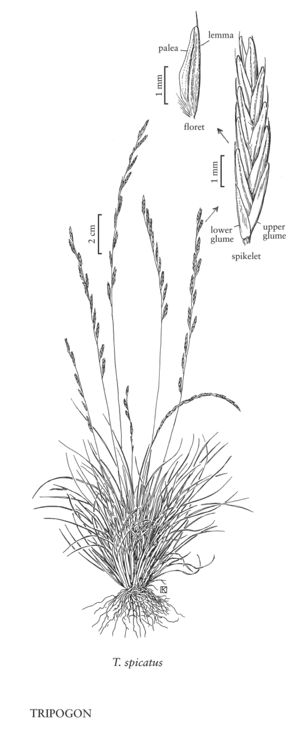Difference between revisions of "Tripogon spicatus"
FNA>Volume Importer |
FNA>Volume Importer |
||
| Line 17: | Line 17: | ||
-->{{Treatment/Body | -->{{Treatment/Body | ||
|distribution=Tex. | |distribution=Tex. | ||
| − | |discussion=<p>Tripogon spicatus grows in shallow rocky soils, usually on granite outcroppings, occasionally on lime¬stone. The flowering period, April-July(October, November), apparently depends on rainfall. Its range includes the West Indies, Mexico, and South America, in addition to central Texas.</p> | + | |discussion=<p><i>Tripogon spicatus</i> grows in shallow rocky soils, usually on granite outcroppings, occasionally on lime¬stone. The flowering period, April-July(October, November), apparently depends on rainfall. Its range includes the West Indies, Mexico, and South America, in addition to central Texas.</p> |
|tables= | |tables= | ||
|references= | |references= | ||
| Line 26: | Line 26: | ||
-->{{#Taxon: | -->{{#Taxon: | ||
name=Tripogon spicatus | name=Tripogon spicatus | ||
| − | |||
|authority=(Nees) Ekman | |authority=(Nees) Ekman | ||
|rank=species | |rank=species | ||
| Line 33: | Line 32: | ||
|basionyms= | |basionyms= | ||
|family=Poaceae | |family=Poaceae | ||
| − | |illustrator=Linda A. Vorobik | + | |illustrator=Linda A. Vorobik;Karen Klitz |
| + | |illustration copyright=Utah State University | ||
|distribution=Tex. | |distribution=Tex. | ||
|reference=None | |reference=None | ||
| Line 39: | Line 39: | ||
|publication year= | |publication year= | ||
|special status= | |special status= | ||
| − | |source xml=https:// | + | |source xml=https://jpend@bitbucket.org/aafc-mbb/fna-data-curation.git/src/f50eec43f223ca0e34566be0b046453a0960e173/coarse_grained_fna_xml/V25/V25_99.xml |
|subfamily=Poaceae subfam. Chloridoideae | |subfamily=Poaceae subfam. Chloridoideae | ||
|tribe=Poaceae tribe Cynodonteae | |tribe=Poaceae tribe Cynodonteae | ||
Revision as of 20:39, 16 December 2019
Plants perennial; cespitose. Culms (4.5)6-34 cm; nodes 2-3, glabrous. Leaves mostly basal; sheaths mostly glabrous, but with tufts of hairs flanking the collar; ligules 0.2-0.3 mm, truncate; blades 1.9-10 cm long, 0.2-1.1 mm wide, glabrous or the adaxial surfaces and margins sparsely pubescent. Inflorescences (1.5)4-10 cm long, 1.5-3.5 mm wide, with (6)13-22 spikelets; pedicels 0-0.5 mm, glabrous. Spikelets 4.5-12 mm long, 1-1.3 mm wide, with 5-14 florets; rachilla segments glabrous except for an apical tuft of hairs. Glumes unequal, exceeded by the basal florets; lower glumes (1.2)1.5-2.4 mm, glabrous, 1-veined, scabridulous over the veins; upper glumes 1.9-2.6 mm, glabrous, 1-veined; lowest lemmas 2.3-3.1 mm, 3-veined, apical sinuses 0.1-0.3 mm deep; awns 0.2-0.9 mm, straight; paleas 1.6-2.4 mm, glabrous on the back and minutely pubescent on the margins; anthers 3, 0.3-0.4 mm, yellow to purple. Caryopses 1-1.5 mm, reddish-brown. 2n = 20.
Discussion
Tripogon spicatus grows in shallow rocky soils, usually on granite outcroppings, occasionally on lime¬stone. The flowering period, April-July(October, November), apparently depends on rainfall. Its range includes the West Indies, Mexico, and South America, in addition to central Texas.
Selected References
None.
